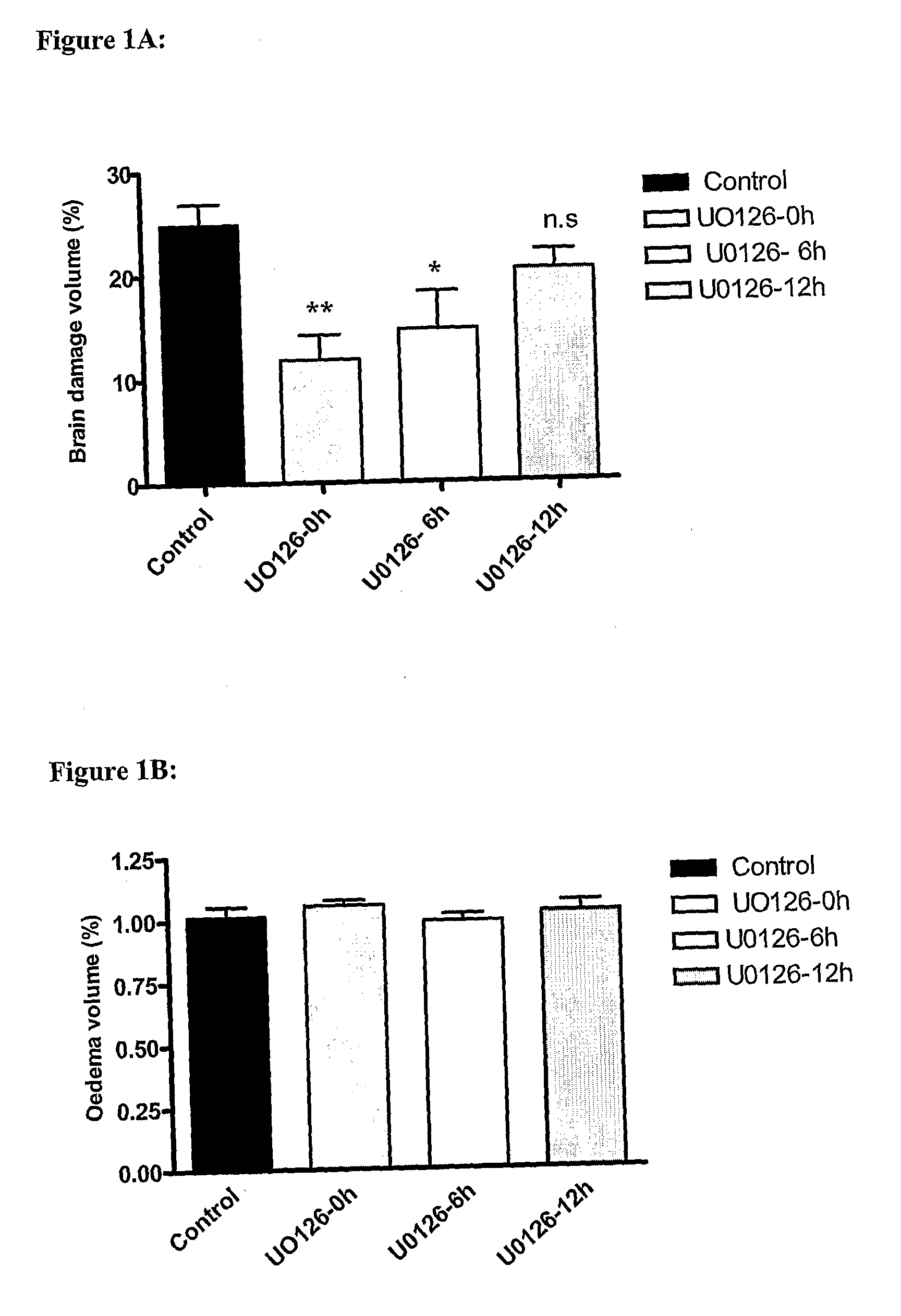Ischemic disorder or disease inhibitors
a technology of ischemic disorder and inhibitor, which is applied in the direction of biocide, plant growth regulator, animal husbandry, etc., to achieve the effect of reducing the size of the infarct and reducing the damage of the ischemic organ
- Summary
- Abstract
- Description
- Claims
- Application Information
AI Technical Summary
Benefits of technology
Problems solved by technology
Method used
Image
Examples
example 1
[0032]All animal procedures were carried out strictly within national laws and guidelines and approved by the Danish Animal Experimentation Inspectorate and the Ethical Committee for Laboratory Animal Experiments at the University of Lund.
Example 2
Rat Subarachnoid Hemorrhage Model
[0033]Subarachnoid hemorrhage was induced by a model originally devised by Svendgaard et al and carefully described by Prunell et al (2003). Male Sprague-Dawley rats (350-400 g) were anaesthetized using 5% halothane (Halocarbon Laboratories, River Edge, N.J.) in N2O / O2 (30:70). The rat was intubated and artificially ventilated with inhalation of 0.5-1.5% halothane in N2O / O2 (70:30) during the surgical procedure. The depth of anaesthesia was carefully monitored and the respiration checked by regularly withdrawing arterial blood samples for blood gas analysis (Radiometer, Copenhagen, Denmark). An electric temperature probe was inserted into the rectum of the rat to record the temperature, which was maintained...
example 2
Rat Subarachnoid Hemorrhage Model with Raf Inhibition
[0035]This group of animals went through the same procedure as the above-mentioned SAH animals. In addition they were treated with 20-50 μl; 10-6 M of SB386023-b (a kind gift from Dr A A Parsons, GSK, UK) or the same volume of vehicle repeatedly 6, 12, 24 and 36 h after the induced SAH. This dose was based on a previous in vivo study with SAH.
Rat Subarachnoid Haemorrhage Model with Protein Kinas C Inhibition
[0036]This group of animals went through the same procedure as the above-mentioned SAH animals. In addition, they were treated with the PKC inhibitor RO-31-7549 (Calbiochem, Sweden) or vehicle in conjunction with the operation and after the induced SAH. All animals treated with RO-31-7549 received five injections intracisternally of RO-31-7549 or vehicle in similar volume. Thus, 20 to 50 μl 10-6 mol / L of RO-31-7549 was injected intracisternally at 30 mins before the induced SAH and after the SAH 20 μl 10-6 mol / L of RO-31-7549 w...
example 3
Autoradiographic Measurements of Regional CBF
[0038]Regional and global cerebral blood flow was measured by a model originally described by Sakurada et al., (1978) and modified by Gjedde et al., (1980). In brief, after 48 hours of observation rats in the various groups (sham, SAH+vehicle and SAH treated with the raf inhibitor) were anaesthetized using 5% halothane in N2O / O2 (30:70). The animal was intubated and artificially ventilated with inhalation of 0.5-1.5% halothane in N2O / O2 (70:30) during the surgical procedure. The anaesthesia and the respiration were monitored by regularly withdrawing arterial blood samples for blood gas analysis (Radiometer AS, Denmark). A catheter to measure MABP was placed in the right femoral artery and a catheter for blood sampling was placed in the left femoral artery. This catheter was connected to a constant velocity withdrawal pump (Harvard apparatus 22, USA) for mechanical integration of tracer concentration. In addition, a catheter was inserted i...
PUM
| Property | Measurement | Unit |
|---|---|---|
| Time | aaaaa | aaaaa |
| Time | aaaaa | aaaaa |
| Pharmaceutically acceptable | aaaaa | aaaaa |
Abstract
Description
Claims
Application Information
 Login to View More
Login to View More - R&D
- Intellectual Property
- Life Sciences
- Materials
- Tech Scout
- Unparalleled Data Quality
- Higher Quality Content
- 60% Fewer Hallucinations
Browse by: Latest US Patents, China's latest patents, Technical Efficacy Thesaurus, Application Domain, Technology Topic, Popular Technical Reports.
© 2025 PatSnap. All rights reserved.Legal|Privacy policy|Modern Slavery Act Transparency Statement|Sitemap|About US| Contact US: help@patsnap.com

